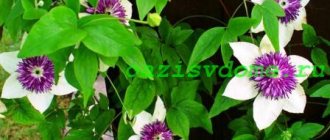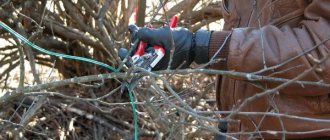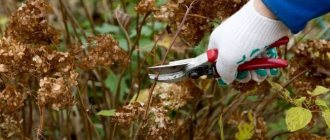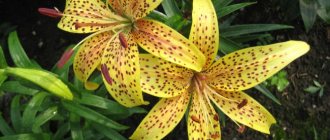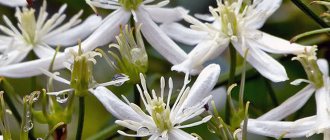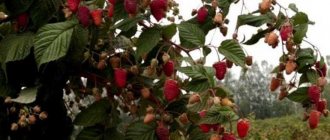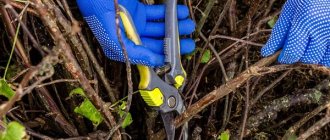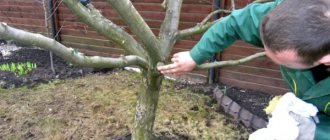The Campsis plant is a woody deciduous vine. Translated from Greek, the scientific name means to bend, bend, twist. Campsis belongs to the Bignoniaceae family, the second name of the plant is bignonia. The genus has only two species, and one has been cultivated in parks and gardens in Europe since the 17th century.
Winter hardiness of Kampsis
The plant is heat-loving, but can overwinter in open ground (with shelter) and even tolerate short-term frosts down to -20° C.
The liana has aerial roots with which it attaches to supports. Most often used in vertical plantings. The leaves are imparipinnate, arranged in 7-11 pieces, and have serrated edges. Flowering lasts from June to September. The flowers are large (length 9 cm, diameter 5 cm), tubular, collected in short paniculate inflorescences at the ends of the shoots. The color of the corollas can be crimson, red-orange, red-golden. The flowers are fragrant, but due to their bright color they attract not only bees, but also wasps, ants, and even flies.
After flowering, the fruit is set in the form of a pod 8-10 cm long. It is filled with many membranous seeds with wings. The ripe pod cracks and the seeds scatter throughout the area. However, fruiting does not always occur. A guarantee of fruit set is the location of a plant clone nearby (offspring of one vegetative propagation).
Planting in open ground
How to plant Kampsis photo
In the conditions of the middle zone, planting in open ground is carried out with the establishment of heat - from the second half of May. Choose a southern or south-eastern area with protection from drafts and strong gusts of wind.
Campsis can grow even on calcareous soils, but for high decorativeness, select fertile, loose, neutral soil, saturated with minerals and trace elements.
Dig a planting hole 40 cm deep, 50 by 50 cm long and wide. Mix the soil taken out of the hole with 5 kg of compost and 0.5 kg of complex mineral fertilizers. Place part of the mixture at the bottom of the planting hole. Spread the roots of the seedling and place it in the hole so that it remains above the soil surface at the same level as it grew before.
Add soil, press lightly, water. When the ground dries out a little, mulch the surface of the soil around the vine with peat or compost. A support needs to be installed. The growth of an actively developing vine must be limited - dig slate and sheets of metal around the root area to a depth of 80 cm.
Planting and propagation
Reproduction of the Kampsis liana is easy: by cuttings, seeds, root shoots and layering.
Planting Kampsis
Caring for and planting Kampsis is no different from most plants. The place should be well lit, without drafts. In the fall, a hole measuring 50x50x40 is dug under the plant, equipped with drainage, then part of the soil is mixed with humus and compost. Enrich the soil with a mineral complex fertilizer containing nitrogen and phosphorus. In the spring, when the threat of frost has passed, the plant is placed in a hole and sprinkled with the prepared soil mixture. Water generously and install support. The flower is actively growing. To limit its reproduction, it is necessary to dig metal sheets around the root system to a depth of 80 cm.
Planting woody cuttings
After pruning the plant in early spring, one-year-old shoots and cuttings are saved. The cuttings are planted at an angle of 45 degrees in nutrient soil in a permanent place. The survival rate of such cuttings is several times higher than that of green cuttings. The cuttings are watered abundantly and shaded at first.
Propagation by seeds
A simple method of reproduction, but it has a number of disadvantages. The species will bloom at 6-8 years of age, but there is no guarantee that all maternal characteristics will be preserved. Seeds do not require cold treatment. In March or April, they are sown in loose neutral soil to a depth of 0.5 cm, covered with film or glass, and then the container is removed in a dark place until shoots appear. The optimal temperature for germination is about 25 degrees. In such conditions, seedlings will appear in a month. When the plant gets stronger and 3 pairs of leaves appear, it can be planted in the garden.
Reproduction by layering
In spring, low-lying branches are pressed to the soil and fixed. During the summer, it is necessary to monitor the soil around the layer; it should be loose and moist. The next year, the cuttings are cut off and transplanted to a permanent place.
Use in landscape design
Campsis is undeservedly rarely used in our gardens. Its unpretentiousness allows it to be grown even on calcareous soils, creating spectacular arches, fences and balconies. Without support, it turns into a ground cover plant. You need to be careful when planting it near gazebos and windows covered with paint. The roots secrete a substance that can spoil the coating, and bright flowers with their rich nectar will attract a large number of insects.
Caring for Kampsis in open ground
The exotic vine is unpretentious in care; for all its unpretentiousness, it grows quickly and is easily restored even after damage by frost.
Watering
Balance is necessary in watering: do not allow prolonged drought or stagnation of water. The liana is quite drought-resistant and can tolerate short-term drying out of the earthen clod, but it is better to water it in a timely manner. To maintain moisture, you can plant bushes of low-growing plants with similar care requirements in the tree trunk circle.
Feeding
The liana grows well without fertilizing, but will respond with abundant flowering throughout the season to the application of nitrogen-phosphorus fertilizer.
Bignonia pruning
Regular pruning is necessary, but only in areas with mild winters and warm summers. In regions with prolonged cold weather, pruning will result in a lack of flowering.
The formation of a bush should begin immediately after planting: cut off the shoots at a height of 15 cm from the soil surface. When they grow a little, you should leave 4-5 of the strongest ones and remove the rest. As they grow, the remaining shoots should be directed along the support and tied up if necessary. The vine will be fully formed in 2-3 years (skeletal branches will reach a length of about 4 m).
Side shoots must be shortened every spring to 2-3 buds. Remove dry, weak, unsuccessfully growing shoots completely. If one of the skeletal branches is severely damaged, it is necessary to remove it and direct the strongest shoot to the place where it grows. To rejuvenate the vine, it is necessary to cut it radically, leaving a length of 30 cm above the soil surface. Carry out the procedure before the kidneys awaken (in early spring).
For longer flowering, it is necessary to remove faded buds throughout the season and cut off faded shoots by 3-4 eyes.
Care
Watering and fertilizing
The plant needs moderate and even watering - neither overmoistening nor prolonged drought should be allowed.
On fertile soils, Kampsis grows without fertilizing for the first 2 years. Nitrogen-phosphorus fertilizers are necessary for lush annual flowering. From April to September, the vine is fed once a month with complete mineral complexes.
Trimming
Campsis with yellow flowers
To get a beautiful plant, formative pruning is carried out in the 2nd year after planting. 4–5 best shoots are left, the rest are removed. In the future, every year in the spring, part of the branches that had flowers last year is cut into 2 buds. Sick, weak and frozen stems are cut out. This will stimulate the growth of young shoots and the formation of many inflorescences.
In the fall, all shoots that have grown beyond the allotted area are pruned. Once every 5–6 years, radical rejuvenation is carried out. Before the buds begin to wake up, all shoots are cut short.
To form a campsis in the form of a trunk, the main shoot is left on the young plant in the first year, the rest are cut out. This stem is attached to a support. The following year, formative pruning is carried out. Gradually, the main shoot becomes strong and does not require support.
Shelter for the winter
Campsis is a heat-loving plant, but tolerates short-term frosts down to -20°C.
For successful wintering, it needs shelter that protects it from damping out and getting wet. With the onset of stable frosts, the shoots are removed from the support and laid on the ground. The plant is covered with spruce branches or covering material, and on top with plastic film. For standard forms, the insulation is attached to the shoots vertically, securing it with wire and ropes.
Preparing Kampsis for winter
In areas with prolonged cold, frosts below 20°C, shelter should be provided for the Kampsis for the winter.
- In the first year, it is recommended to grow the vine in a container, and move it to the cellar for the winter.
- Next, it is better to use removable supports that can be easily removed at the end of the season and installed again in the spring.
- Wintering is similar to grapes: remove the shoots from the support, lay them on the soil with spruce branches, cover them with a film, and throw leaves and other organic remains on top of the film.
- In winter, it is useful to heat up additional snow. Then even young branches will not suffer in the most severe frost (good shelter allows you to preserve the vine even in the conditions of the Urals).
Use in landscape design
Tekoma is an excellent designer of a summer cottage. It will decorate any wall, be it a fence or a residential building. Campsis can be used to decorate a terrace or gazebo. Beautiful lush flowers will delight you with their beauty for a very long time, and the foliage will fall only in late autumn.
Campsis in landscape design
Bignonia can also be combined with other plants. For example, clematis. Lavender, sage and geranium are suitable as pasture plants.
Campsis is a perennial plant that came to us from the tropics. Landscape design decoration. Often found in private plots of the Moscow region. Its cultivation and care will not be difficult. Requires shelter for the winter. It is a sun-loving plant, so this condition must be taken into account when choosing a place for planting.
Campsis - flowering liana: video
Campsis in landscape design: photo
Why doesn't Kampsis bloom?
Cold climate, strong drafts, late frosts in spring, pest diseases are possible reasons for the lack of flowering of bignonia. It is worth noting that flowering of campsis grown from seeds should be expected in the 4-6th year after germination. Rooted cuttings bloom in the 3rd year.
If bignonia is grown in cold regions, it should not be pruned: the vine easily tolerates it, but does not have time to form flower buds. Therefore, if your city has a fairly cold climate, it is absolutely impossible to prune Kampsis.
Diseases and pests of Kampsis
Aphid on Kampsis photo
Due to waterlogging of the soil, the root system may begin to rot; it is necessary to treat with a fungicide and adjust the watering regime.
In particularly hot weather, aphids may appear on the vine - treat with a soap solution (10 g of tar soap per 10 liters of water). If the pests are not killed, treat with insecticides.
Description of Kampsis
The smooth branching stem can grow up to 15 m. Young shoots have a light green color; with age, the vine becomes woody at the base, acquiring a more pronounced burgundy hue. Small internodes are found along the entire length of the plant. From them originate the aerial root system of Campsis, its petioles, which reach large sizes, each with 8-10 glossy leaves covered with vegetable wax.
The reverse side of the ellipse-shaped leaf has many veins, along which there is characteristic pubescence. The flowers are tubular in shape, often orange-red, pink or yellow, on average 5-8 pieces, and have no scent.
The fruit is a hard, elongated pod up to 8-10 cm, containing numerous brown seeds. The roots are well developed, growing both deep into and around the campsis, occupying a large space.
Growing Kampsis from seeds
Capsis seeds photo
Seed and vegetative (cuttings, layering, root shoots) propagation is possible.
The disadvantage of seed propagation is the loss of varietal characteristics (if the seeds are collected from hybrid forms); flowering of a new plant occurs after 4-6 years of life. But there is enough planting material. Store seeds at room temperature until spring; pre-treatment before sowing is not required.
Campsis from seeds photo
- Take a box with loose, breathable soil of neutral reaction, the seeding depth is about 5 mm, the distance between seeds is 2-3 cm.
- Cover the crops with film. Maintain the air temperature at 25º C, regularly ventilate the greenhouse and water through a pan. Expect the emergence of seedlings in a month, after which remove the cover.
- When three true leaves appear, replant the young plants in separate containers.
- Plant stronger plants in open ground from the second half of May.
Reproduction of Kampsis by cuttings
Campsis cuttings photo of aerial roots on a stem
At high humidity, the rooting capsis produces aerial roots directly at the internodes of the stem. This property is widely used for rapid rooting of green cuttings.
Lignified cuttings
Lignified cuttings can also be used for propagation. They are cut from one-year-old shoots in early spring and planted directly into open ground at an angle. You can also root in the fall in cut plastic bottles: by spring you will have planting material ready for planting.
Lignified Kampsis cuttings have sprouted photo
Green cuttings
Rooting of green cuttings is carried out in June-July. Leave 2-3 sheets on them, shortening them by half their length. Plant in a bed with fertile, loose soil, place the cutting at an angle of 45º, water, mulch, and keep the soil constantly moist. Similarly, green cuttings can be rooted in any container indoors. The main condition is loose water- and breathable soil, good lighting and constant humidity of the substrate without stagnant water (be sure to make drainage holes if there are none).
Reproduction of Kampsis by root shoots and layering
Reproduction of Kampsis by root suckers photo
In the fall (after the leaves fall) or in the spring, you can plant root shoots. Dig it up along with part of the root and plant it in a place of permanent growth.
Propagate by layering in the spring. A shoot growing close to the soil surface should be bent down and covered with earth. Maintain soil moisture in the digging area and periodically loosen the surface. Separate the cuttings from the mother plant next spring. Plant in a permanent growing location and water well.
Types and varieties of Kampsis with photos and names
Campsis rooting Campsis radicans or bignonia rooting Bignonia radicans
Campsis rooting Campsis radicans variety Minnesota Red photo
Originally from North America. The length of the vine is about 15 cm. The imparipinnate leaves reach a length of 20 cm, consist of 9-11 leaf blades, are painted bright green, the surface of the leaf blades is smooth, and pubescence runs along the veins on the reverse side. Tubular flowers 9 cm long have a diameter of up to 5 cm, collected in 10-15 pieces. on the tops of the shoots. The corolla has a bright orange color, the limb is fiery red. Flowering starts in mid-summer, the buds open sequentially. The fruit is a pod 5-12 cm long.
Subspecies of Kampsis rooting:
- Bignonia is magnificent - the vine climbs weakly, more like a bush with thin long shoots. The leaf blade consists of small oval-shaped leaves. The flowers are red-orange in color.
- Golden bignonia has bright yellow flowers.
- Bignonia early – flowering occurs a month earlier than the species plant. The flowers are large, fiery red in color.
- Bignonia dark purple - large flowers are dark red with a purple tint.
Getting to know Kampsis
Campsis is a deciduous woody vine belonging to the Bignoniaceae family.
The flower owes its name to the Greek word, which translated means “to bend”, “to twist”, “to bend”. This plant is a honey plant, loves warmth very much and during flowering pleases with bright buds. Due to its excellent frost resistance in the middle zone, including the Moscow region, Kampsis took root without problems. Moreover, gardeners fell in love with it for its decorative properties, trouble-free cultivation and ease of care.
Campsis is often confused with Tecomaria or Tecoma. But these are different plants, despite the fact that they belong to the same family.
The foliage of the vines is imparipinnate, and each leaf is folded and includes 7-11 small leaflets, a characteristic feature of which is a serrated edge. The plant begins flowering in July and continues until September with the blooming of large buds (9*5 cm) of a tubular shape. They are collected in long panicles and located at the ends of the shoots. The color of the buds is varied: pink, orange, red, crimson, etc.
At the end of flowering, the fruit develops - a two-leaf pod filled with seeds with “wings”.


